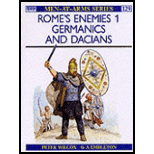I needed to paint up the shields for my ancient Germans, and decided to do a bit of background research to pick color schemes and patterns that at least gave a nod to historical accuracy. Here's what I discovered.
- - Germanic tribes arrived in continental Europe from Scandinavia. Around 250 BC they had begun migrating south from the northern coasts, with the Rhine serving as a cultural border between them and the flourishing Celtic cultures to the west.
- Along the Rhine border, a number of influences spread into Germanic culture. Germanic shields are a prime example, being similar to the styles used by Celts of that time : ovals, rounded corner rectangles and hexagonal. Over several centuries Germanic shields took on additional Celtic influences before being replaced by the circular styles typically associated with the Vikings.
- Shields were wooden (formed from either a single piece of wood, or from two or three planks "glued" together with a resin putty). The center of the shield was hollowed out to provide a hand grip, with a wooden or iron boss covering the hand grip on the shield's face. The shield was held in front of the warrior, and didn't feature an arm strap affixing it to the forearm. The exterior of the shield was clothed in hide or leather. Tacitus, writing in the 1 C AD, (Annals II.13) has Germanicus say in AD 16:- "...even their shields are not reinforced with iron or leather, but are merely plaited wickerwork or flimsy painted boards..." and in the 'Germania' "...there is nothing ostentatious about their equipment: only their shields are picked out in the colours of their choice..." It's likely Germanicus was playing down the quality of the German arms since he was addressing his troops at the time and trying to pump them up for the coming battle.
- Shields have been discovered at several archeological sites. Because ancient European tribes often ritually sacrificed arms, armor and treasure, many artifacts have been pulled from the bogs that served as their ritual graves. The Hjortspring boat’, Deal Warrior’ shield in Kent, and Salisbury Hoard votive shields are all actual shields or ceremonial replicas. The Portonaccio Sarcophagus also features Roman representation of German shields.
- The designs painted on German shields are virtually non-existent. A few thousand years buried in a bog tends to scour away any sort of painting or decoration. Actual shield designs for Celts and Gauls are more common. Because there was some cultural overlap between Celts and Germans I decided to take a look at Celtic shield designs as well. Celtic shields can be seen on the Pergamene marble relief from the sanctuary of Athena Nikephoros (showing a Galatian shield), a terracotta figure from 3rd Century BC Egypt of a Gaul, as well as a number of coins commemorating triumphs over Gallic warriors.
In the end, there isn't a lot to go regarding "authentic" shield designs. I created a quick mock up in Photoshop to test out some designs.
 |
| My fanciful ancient German shield designs. |
Since I'd be painting these by hand I wanted to use fairly simple geometric patterns. Even though each shield is unique, I wanted the unit to have a cohesive look, so I limited my color palette to the shades I used in painting the clothes of my ancient Germans. It took working on these over several nights to finish all 30 (they were a lot more fiddly to deal with than I expected), but they are done and ready for my Germans. Once the unit is complete I'll get a pic posted.
Here's one of the books I used for reference:



Thanks for this. Just starting a German army for Sword and Spear and a little surprised at the lack of transfers. Will try some of your ideas on my Warlord shields, if that's O.K. with you.
ReplyDeleteSure Philip, feel free to use them! I'd love to see how yours turn out :)
Delete